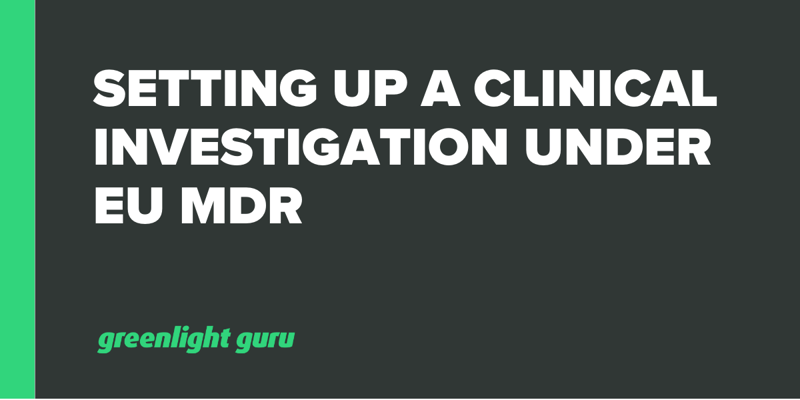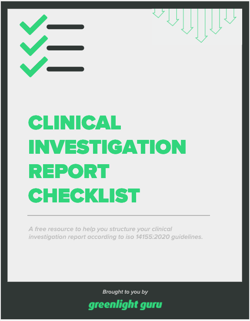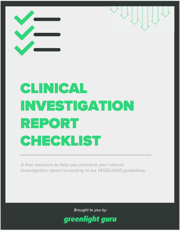
The European Union Medical Device Regulation (EU MDR) defines a clinical investigation as “any systematic investigation involving one or more human subjects, undertaken to assess the safety or performance of a device.”
For Class III or Class II implantable medical devices, a clinical investigation is a necessary part of performing the clinical evaluation required to obtain a CE Marking and market your product in the EU. And as you would expect, any study involving real patients will need to meet a number of regulatory requirements—many of which must be met before the study begins.
To help you get a handle on those requirements, there are several steps I’d recommend you take as you set up your clinical investigation in the EU:
Read up on the changes to clinical investigation requirements under EU MDR
On May 26, 2021, the European MDR went into effect and its predecessor, the Medical Device Directive (MDD) was repealed.
This has had a meaningful impact on many areas of medical device regulation, and clinical investigations are no exception. The MDD contained just one article on the subject, which has been replaced with twenty new articles in MDR, spanning articles 62 to 82.
While these articles are much more detailed, they cover similar material as the MDD. In them, you’ll find information on:
-
The conduct of clinical investigations
-
The general requirements for clinical investigations
-
Informed consent
-
Clinical investigations on subjects requiring special consideration
-
The application process and assessment by Member States
If you have experience with clinical investigations, many of the requirements in MDR will seem familiar. That’s because they were intentionally based on the international standard for clinical investigation of medical devices for human subjects, ISO 14155, as well as European guidance documents like MEDDEV 2.7/4.
It’s important to note that ISO 14155 was updated in 2020 and this updated version has yet to be harmonized with MDR. However, the update attempted to avoid any conflicts with MDR, and ISO 14155:2020 is expected to be harmonized with MDR in the near future.
While MDR offers more detail on the requirements for clinical investigations, it’s highly recommended that you get a copy of ISO 14155:2020 before you begin planning your clinical investigation.
Choose the appropriate regulatory pathway based on the type of clinical investigation you want to perform
There are several different reasons you may want to perform a clinical investigation, and certain situations call for specific regulatory pathways. Most medical device companies will be conducting a premarket clinical investigation as part of their clinical evaluation, or a post market clinical follow up (PMCF) investigation as part of their post market surveillance (PMS) activities.
However, there are three regulatory pathways you can use, which are covered by Article 62, Article 74(1), and Article 82 of MDR respectively.
-
Article 62 covers investigations that are performed in order to demonstrate conformity and obtain a CE marking. This is the pathway medical device companies will use if their device classification (Class III or Class IIb implantables) requires a clinical investigation.
-
Article 74(1) covers the regulatory pathway for devices that already have a CE marking if the parameters of the investigation are within the device’s intended purpose. In other words, if you are conducting a clinical investigation as part of your PMCF), then you will be guided by Article 74(1).
-
Article 82 covers clinical investigations that are not being performed in order to demonstrate conformity. Additionally, the member state in which you hold your study may have relevant national provisions for you to follow.
If this feels like a lot to wrap your head around, then this flowchart should help clarify the regulatory pathway that you will take:

Annex I: Clinical Investigation under MDR - regulatory pathways, MDCG 2021-6 (Source)
Create your CIV-ID and get approval from the relevant competent authority
Before you can begin your clinical investigation, it needs to be approved by the EU Member State(s) in which it will take place. The first step in getting that approval is getting your study’s CIV-ID.
The CIV-ID is an EU specific tracking number that competent authorities in any Member State can use to identify and track your clinical investigation. The European Commission (EC) has put out guidance on generating your CIV-ID which recommends that you obtain it before submitting your application/notification to any competent authority.
Keep in mind, the CIV-ID system of tracking clinical investigations won’t be around for too much longer. EUDAMED is scheduled to become fully functional in May 2022, and when that happens, study sponsors will be able to generate a Single Identification Number (SIN) that will take the place of the CIV-ID.
For now, once you have your CIV-ID, you can submit your application/notification to any Member States in which you are planning to conduct your clinical investigation. Chapter II, Annex XV of MDR outlines the documentation you’ll need. However, the EC has also provided templates for these documents in their guidance document, MDCG 2021-8.
Similar to the CIV-ID, these templates are intended to be used until the EUDAMED module for clinical investigations is active. At that point, the templates will be withdrawn and sponsors will instead use the EUDAMED.
Ensure all clinical study activities are documented and organized in your QMS
Whether you’re conducting a pre-market clinical investigation as part of obtaining your CE marking or carrying out a PMCF investigation as part of your PMS activities, the results of your clinical investigation must be managed within your Quality Management System (QMS).
Your pre-market clinical investigation will be part of your clinical evaluation report (CER), which is the document that demonstrates to your Notified Body that your device performs as intended without compromising the safety of patients or users.
The CER is a living document, and you’re required to update it when you obtain new information from your PMS activities that may change your clinical evaluation—perhaps because it alters your benefit-risk profile.
Clinical studies conducted after your device is on the market, as part of your PMCF, must be documented in your PMCF evaluation report. However, the study will likely result in an update to your CER, as well.
The point is that your QMS should be set up to ensure that the links between different elements are clear, and that you can immediately understand the deeper impacts of any change along with what will need to be updated.
Get your CE Marking faster with an interconnected, visible & intuitive QMS from Greenlight Guru
If you’re wondering what type of QMS meets those requirements, then look no further than Greenlight Guru’s QMS software.
With Greenlight Guru, you can stop relying on disconnected systems and start building, seeing, and achieving closed-loop traceability. Not only will your quality system become connected, it will become visible. You’ll be able to better comprehend and communicate the relationships in your quality system while keeping track of the details and trending quality information.
If you’re ready for a QMS that will help you better navigate and understand your quality system, then get your free demo of Greenlight Guru today →
Looking for a design control solution to help you bring safer medical devices to market faster with less risk? Click here to take a quick tour of Greenlight Guru's Medical Device QMS software
Benjamin Bancroft is a Medical Device Guru at Greenlight Guru who enjoys working on audits, CAPAs and Root Cause Analysis. He is a Quality and Regulatory Manager who began his career maintaining the QMS for multiple companies as a CAPA and audit SME. He enjoys helping customers successfully navigate regulations to...
Related Posts
MEDDEV 2.7/1 Rev. 4 & MDCG Guidance: Carrying Out Clinical Evaluation Under EU MDR
Ultimate Guide to Device Class Requirements under EU MDR
Who are the Economic Operators & What Does EU MDR Require of Them?
Get your free resource
Clinical Investigation Report Checklist











